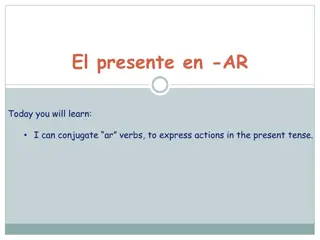Understanding Gustar with Emphasis & Clarification in Spanish
Learn how to use Gustar with emphasis and clarification in Spanish to express likes with different levels of emphasis and specify the person being talked about. The explanation is supported with helpful charts and examples. Practice constructing sentences following a four-step system to reinforce your understanding. Improve your Spanish language proficiency with this comprehensive guide.
Download Presentation

Please find below an Image/Link to download the presentation.
The content on the website is provided AS IS for your information and personal use only. It may not be sold, licensed, or shared on other websites without obtaining consent from the author. Download presentation by click this link. If you encounter any issues during the download, it is possible that the publisher has removed the file from their server.
E N D
Presentation Transcript
Gustar with an Infinitive & Emphasis/ Clarification Avancemos 1 Unidad 1 Lecci n 1
Gustar with Emphasis & Clarification What does Le gusta estudiar mean in English? Are there multiple meanings? Yes. Le gusta can mean he/she/you (form) likes When you want to add emphasis to a phrase or identify the person that you are talking about, you can add clarification to the sentence. Use the chart to help you form the sentences.
Gustar with Emphasis & Clarification Emphasis/Clarification Optional but necessary with 3rd person A subject pronoun/name IOP Indirect Object Pronoun Gusta What you like (infinitive verb) (A m ) me (A ti) te (A l/A ella/A Ud.) le nadar leer dibujar etc. gusta (A nosotros) nos (A vosotros) os (A ellos/A ellas/A Uds.) les ********Please note that we can also use names in step 1, as long as they are preceded by A
Gustar with Emphasis & Clarification A m me gusta dibujar. I like to draw. A ti te gusta dibujar. You like to draw. A l le gusta dibujar. He likes to draw. A ella le gusta dibujar. She likes to draw. A usted le gusta dibujar. You (form) like to draw. A nosotros nos gusta dibujar. We like to draw. A ellos les gusta dibujar. They like to draw. A ustedes les gusta dibujar. You all like to draw.
Gustar with Emphasis & Clarification This first step is optional in most cases and is used to emphasize (A m me gusta chocolate emphasizes that you really like chocolate). It is also used to clarify who is being spoken about. (Le gusta or les gusta do not tell us exactly who we are talking about) It is generally necessary to use A . when using 3rd person sentences because you need clariifcation on who le and les are. When using the 1st step, please note that it ALWAYS BEGINS WITH A ..
Prctica Write the following sentences using the 4 step system 1. A ella le gusta correr. 1. She likes to run. 2. We like to eat. 2. A nosotros nos gusta comer. 3. They like to rest. 3. A ellos les gusta descansar.
Ms Prctica Write the following sentences using the 4 step system 1. I like to drink water. 1. A m me gusta beber agua. 2. You (fam) like to rent a DVD. 2. A ti te gusta alquilar un DVD. 3. They don t like to study. 3. A ellos no les gusta estudiar. 4. We like to take a walk. 4. A nosotros nos gusta pasear. 5. The students like to write emails. 5. A los estudiantes les gusta escribir correos electr nicos. 6. Mar a likes to play soccer. 6. A Mar a le gusta jugar al f tbol. 7. Juan doesn t like to eat pizza. 7. A Juan no le gusta comer pizza. 8. You (form) don t like to draw. 8. A usted no le gusta dibujar. 9. The girl likes to skateboard. 9. A la chica le gusta andar en patineta. 10. Mar a and I like to buy ice cream. 10. A Mar a y a m nos gusta comprar el helado.























